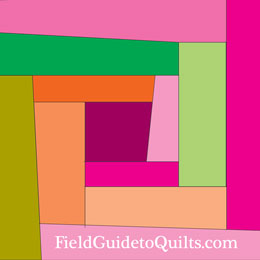| FieldGuidetoQuilts.com |

|
| In a traditional Log Cabin block, different shades of similar colors meet end to side. The center square is often in a contrasting color. |
|
 |
In a Straight Furrow/Barn Raising/Light & Dark block, shades of two different colors are in opposite corners. Similar colors meet end to side. |
| In a Courthouse Steps block, the colors are mirrored on opposite sides. Different colors meet end to side. |















 Barn Raising quilt
Barn Raising quilt Straight Furrow quilt
Straight Furrow quilt Log Cabin Spiral
Log Cabin Spiral Streak o' Lightnin'
Streak o' Lightnin' Zig Zag quilt
Zig Zag quilt Sunshine & Shadows
Sunshine & Shadows Log Cabin Pinwheels
Log Cabin Pinwheels Log Cabin Star
Log Cabin Star Courthouse Steps
Courthouse Steps Courthouse Steps
Courthouse Steps White House Steps
White House Steps
 Log Cabin
Log Cabin Greek Key
Greek Key American Log Patchwork
American Log Patchwork

 Pineapple Hexagon
Pineapple Hexagon Pineapple Hexagon
Pineapple Hexagon Pineapple Hexagon
Pineapple Hexagon Swirling Hexagon (Parfait Cafe)
Swirling Hexagon (Parfait Cafe) Swirling Hexagon
Swirling Hexagon Log Cabin Hexagon
Log Cabin Hexagon Log Cabin Hexagon
Log Cabin Hexagon Wonky Log Cabin
Wonky Log Cabin  Crazy Courthouse Steps (Pridemore)
Crazy Courthouse Steps (Pridemore)
 Crazy Courthouse Steps
Crazy Courthouse Steps